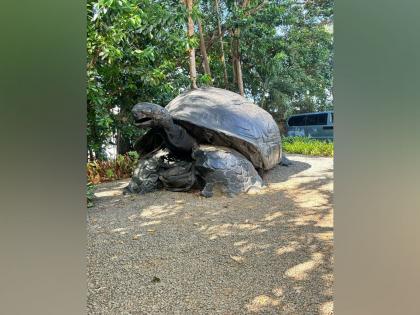Roaming free in paradise: Seychelles' giant tortoises and their special bond with India
By ANI | Updated: October 29, 2025 22:40 IST2025-10-29T22:35:48+5:302025-10-29T22:40:06+5:30
Victoria [Seychelles], October 29 : The Seychelles is renowned for its iconic giant tortoises, specifically the Aldabra giant tortoise, ...

Roaming free in paradise: Seychelles' giant tortoises and their special bond with India
Victoria [Seychelles], October 29 : The Seychelles is renowned for its iconic giant tortoises, specifically the Aldabra giant tortoise, which can live for over 150 years. These gentle giants are a major tourist attraction and can be found roaming freely in the National Botanical Garden.
Aldabra tortoises are one of the largest tortoise species in the world, with males weighing up to 550 pounds. They have a dark grey to black colour, a highly domed, thick carapace, and a small neck plate. Their long necks help them gather food from trees. They feed on leaves, fruits, and low-hanging branches.
The National Botanical Garden is a popular tourist spot, and the giant tortoises are the main attraction. Visitors can feed them and interact with these incredible creatures. Cammilie, the caretaker of the giant tortoises, toldthat they are herbivores that feed on leaves, fruits, and low-hanging branches.
The giant tortoises symbolise the strong bond between India and Seychelles. In 2018, Seychelles gifted a pair of Aldabra giant tortoises to India, which were housed at the Nehru Zoological Park in Hyderabad.The famous giant tortoises of Seychelles share a bond with India through historic gifts and modern diplomacy.
This gesture symbolises the strong bond between India and Seychelles, with the tortoises serving as ambassadors of friendship and conservation.
Seychelles has protected areas, such as the Aldabra Atoll, which is home to around 100,000 giant tortoises. Many luxury resorts in Seychelles operate under strict environmental guidelines and participate in tortoise breeding programs.
A tourist, Leonie, who was thrilled to see them. She told ANI, "I've never seen such huge tortoises before."
Aubrey Sophola, a local, told that the giant tortoises are a major draw for tourists. "They're the main attraction here, and people come from all over the world to see them," he said.
Aldabra tortoises' carapace (or upper shell) has a small neck plate that is usually visible, a feature absent in other species of giant tortoises. The males have a concave plastron (belly shell) that aids in mating. They are dark gray to black in color with a highly domed, thick carapace.
They have long necks, which helps with food gathering. The hind legs are cylindrical and columnar like those of an elephant; thick, often bony scales cover them. The toes are short and two-jointed. The head is relatively small, pointed and covered by scales, Smithsonian's National Zoo and Conservation Biology Institute states.
A rare subspecies of Aldabra tortoise has been discovered in approximately ten zoos around the United States. The Aldabra tortoises at the Reptile Discovery Center have not yet been DNA tested to determine if they fall under this category.
Disclaimer: This post has been auto-published from an agency feed without any modifications to the text and has not been reviewed by an editor
Open in app